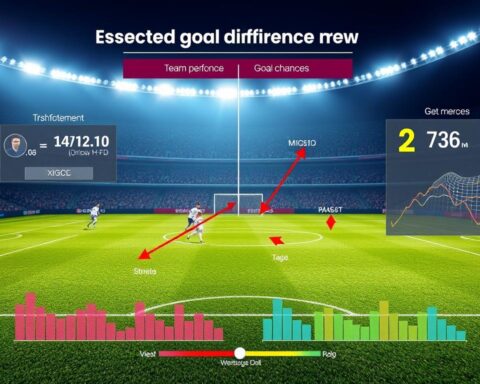Did you know that the Singular Value Decomposition (SVD) of a matrix can be expressed with an elegant formula : A = UΣVT, where U and V are orthogonal matrices, and Σ is a diagonal matrix1? This mathematical marvel not only simplifies complex data structures but also supports a host of advanced applications within data science and signal processing2.
Singular Value Decomposition, originally developed in the 1930s by Carl Eckart and Gale Young, continues to be instrumental in modern computing1. Whether it’s for dimensionality reduction or noise reduction, the SVD implementation leverages linear algebra to break down matrices into components that are easier to manage and analyze. This becomes significantly important in fields such as image compression, recommendation systems, and even machine learning pipelines that utilize software like Scikit-Learn and TensorFlow.
This guide aims to provide you with a detailed introduction to implementing Singular Value Decomposition using a Python algorithm. By the end of this section, you will have a thorough understanding of the theoretical underpinnings of SVD and practical insights into its execution. We will guide you through step-by-step implementations using Python’s NumPy and SciPy libraries, ensuring you are well-equipped to apply this technique effectively.
Key Takeaways
- Singular Value Decomposition (SVD) is foundational in numerical analysis and linear algebra.
- The SVD formula for a matrix is A = UΣVT, where U and V are orthogonal, and Σ is diagonal1.
- SVD has critical applications in data science, including dimensionality reduction, noise reduction, and image compression2.
- SVD supports advanced machine learning pipelines in software like Scikit-Learn and TensorFlow.
- This guide provides hands-on implementation of SVD using Python’s NumPy and SciPy libraries.
Introduction to Singular Value Decomposition (SVD)
Singular Value Decomposition (SVD) emerges as a sophisticated algebraic methodology, integral to the manipulation of complex matrices within linear algebra. It decomposes a matrix into three matrices: U, Sigma, and V^T, where A = UDV^T3. This decomposition simplifies complex problems, rendering SVD essential in advanced algorithms and systems.
SVD distinguishes itself by accommodating both rectangular and square matrices, a feature not shared by other techniques like spectral decomposition3. The matrix A, an m x n matrix4, undergoes decomposition into U, Sigma, and V. These matrices facilitate tasks such as dimensionality reduction and noise reduction, critical in machine learning and statistics.
Compared to eigenvalue decomposition, SVD excels in handling rectangular matrices more efficiently3. The transformation of A into a square matrix through SVD enables the computation of eigenvalues, vital for the development of the decomposed matrices4. The eigenvalues, arranged in descending order in the Sigma matrix, underscore their importance in the decomposition.
The eigenvectors, derived from eigenvalues, form the singular vectors, leading to the formation of U and V^T by normalization4. This process treats rows as d-dimensional points, fitting lines through them to define singular vectors effectively3. The singular vectors maintain an orthonormal relationship, making them ideal for applications like PCA and image compression3.
SVD’s utility extends across both theoretical and practical domains, finding a home in data science, software like Scikit-Learn and TensorFlow, and various applications. It is employed in collaborative filtering, recommendation systems, visualization tasks, and spectral decomposition techniques3. SVD’s role in computing the best k-dimensional subspaces and in noise reduction solidifies its status as a cornerstone in advanced computational methodologies3.
| Matrix | Dimensions |
|---|---|
| A | m x n |
| U | m x k |
| Sigma | k x k |
| V | n x k |
History and Development of SVD
The inception of Singular Value Decomposition (SVD) in the 1930s heralded its indispensable role in contemporary data science. Its enduring relevance is a reflection of its theoretical solidity and practical efficacy. This discourse delves into the origins, seminal contributions, and contemporary applications of SVD.
Origins in the 1930s
The genesis of SVD was embedded in the pursuit of matrix factorization methodologies in the 1930s. Mathematicians endeavored to devise systematic methodologies to dissect complex matrices into more tractable forms. These endeavors served as the foundational bedrock for the exhaustive development of SVD in subsequent eras.
Contributions by Carl Eckart and Gale Young
Carl Eckart and Gale Young were instrumental in codifying the SVD algorithm. Their meticulous work elucidated the decomposition of a matrix into three distinct entities: U, Σ, and VT5. This foundational achievement not only offered a systematic framework for matrix decomposition but also facilitated the extension of SVD’s applicability across diverse domains6.
Adoption in Modern Data Science
In the realm of contemporary data science, SVD has garnered widespread adoption due to its versatility and resilience. Its utility in image compression, where low-rank approximations simplify complex data sets without compromising information integrity, is exemplary5. Further, SVD’s indispensable role in Principal Component Analysis (PCA) enables the reduction of high-dimensional data to its most salient features, facilitating in-depth analysis7. Its integration into frameworks such as Scikit-Learn and TensorFlow highlights SVD’s critical function in sophisticated machine learning architectures6.
SVD’s prowess in denoising and solving linear systems further cements its versatility in addressing myriad real-world challenges. Its applications span facial recognition, recommender systems, and beyond, underscoring its unparalleled utility in the modern data science paradigm7. Through the seamless amalgamation of theoretical constructs with practical applications, SVD continues to demonstrate its unmatched utility in the data science domain.
The statistical breakdown of SVD’s impact in these fields is illustrated as follows:
| Application | Impact |
|---|---|
| Image Compression | Reduces data complexity, preserving key features while minimizing storage requirements. |
| Principal Component Analysis (PCA) | Facilitates dimensionality reduction by identifying dominant patterns in high-dimensional data. |
| Recommender Systems | Optimizes recommendations by simplifying user-item interaction matrices, enhances predictive accuracy. |
| Facial Recognition | Improves accuracy by efficiently capturing and comparing distinctive facial features. |
| Solving Linear Systems | Provides precise solutions to systems of linear equations, critical in engineering and scientific computations. |
Understanding the Mathematical Foundations of SVD
At the core of SVD mathematical theory is its capacity to dissect any matrix into three critical components: the matrix of left singular vectors (U), the diagonal matrix of singular values (Σ), and the matrix of right singular vectors (V)8. This framework, conceived by Carl Eckart and Gale Young, is fundamental in linear algebra. It extends the eigendecomposition of square matrices to any rectangular matrix, providing a more adaptable tool for data analysis9.
SVD’s decomposition uncovers vital insights into the geometric interpretations of linear transformations, including stretching, compressing, and rotating spaces9. The orthogonal nature of matrices U and V ensures that the transformations preserve vector norms. This property enhances computational efficiency and stability in matrix operations10.
For instance, Matrix B, with values \([-1, 1], [0, -2]\) has eigenvalues of \([-1, -2]\) and eigenvectors \([[1, -0.70710678], [0, 0.70710678]]\)8. These orthogonal matrices are critical in various linear transformations. They maintain straight lines before and after the transformation, ensuring geometric consistency and integrity10.
SVD’s versatility makes it a widely adopted technique in modern data science applications such as dimensionality reduction, noise reduction, image compression, and collaborative filtering8. For example, in data compression, retaining only the top N singular values can significantly reduce data size while preserving critical information10. This capability to distill complex data into its most informative components is invaluable to machine learning pipelines and various analytical processes8.
The Role of Linear Algebra in Singular Value Decomposition
Singular Value Decomposition (SVD) is rooted in the foundational theories and methodologies of linear algebra, essential for the manipulation of complex data and transformations11. The application of linear algebra in SVD enables the decomposition of a matrix into three fundamental components: U, S, and V. This decomposition simplifies matrices, rendering them more amenable to analysis and manipulation12. Such transformation is critical for the efficient interpretation and processing of data across diverse disciplines.
The understanding of SVD is inextricably linked to the principles of matrix operations, including matrix multiplication and diagonalization. Pioneers such as Carl Eckart and Gale Young, who first elucidated the core aspects of SVD in the 1930s, underscored the significance of these operations in dissecting matrices into their constituent parts12. Diagonalization, which transforms a matrix into a diagonal form, is central to SVD. This process distills the complexities of the original matrix into singular values, which are indispensable for various computational tasks.
The practical application of these theories demonstrates SVD’s proficiency in tasks such as dimensionality reduction, data compression, and matrix approximation11. These tasks are fundamental to the effective processing and interpretation of large and complex data sets, a ubiquitous challenge in contemporary data science11. The orthogonal matrices (U and V) and the diagonal matrix (S) containing singular values play critical roles in these operations, optimizing data handling systems and augmenting computational efficiency12.
Consider Python’s scipy library function scipy.linalg.svd(). This function exemplifies SVD’s application in decomposing matrices to solve systems of equations, illustrating the algorithm’s practical utility through real-world programming12. Such implementations are vital for advanced machine learning pipelines, often found in platforms such as Scikit-Learn and TensorFlow, enabling the application of SVD principles to address real-world challenges.
The interplay between vector spaces, transformations, and diagonalization highlights the critical role of linear algebra in SVD’s operational success. These elements facilitate the method’s ability to simplify and transform matrices, making data processing and analysis more efficient and effective. As SVD continues to be an indispensable tool in data science, a deep understanding of its linear algebra foundations remains essential for maximizing its utility.
| Core Components | Description | Application |
|---|---|---|
| Matrix Multiplication | Combines matrices to form a resultant matrix, foundational to SVD | Efficient data processing |
| Diagonalization | Transforms matrices into diagonal form, simplifying complex matrices | Dimensionality reduction, system solving |
| Orthogonal Matrices | Matrix rows and columns are orthogonal unit vectors | Noise reduction, data interpretation |
| Singular Values | Values on the diagonal of the diagonalized matrix, representing essential data | Principal Component Analysis, data compression |
Key Properties and Theorems of SVD
Singular Value Decomposition (SVD) exhibits several critical properties, essential for data science and other disciplines. It decomposes any matrix into UΣVᵀ, comprising orthogonal matrices U and V, and a diagonal Σ containing singular values13. This decomposition is fundamental for grasping the data’s underlying structure.
Orthogonal Matrices and Eigenvectors
In the SVD process, U and V, as orthogonal matrices, are of utmost importance. They are composed of orthonormal eigenvectors from AAᵀ and AᵀA, respectively13. The significance of orthonormal eigenvectors lies in simplifying data transformations and preserving vector orthogonality and unit length. This property is invaluable in applications like PCA, where it aids in identifying data’s principal components by projecting onto orthogonal bases14.
Diagonal Matrices and Singular Values
The diagonal matrix Σ in SVD encapsulates singular values, which are the square roots of AAᵀ and AᵀA’s non-zero eigenvalues15. These values are critical, as they signify the importance of data components. They facilitate dimension reduction by retaining significant features while discarding less important ones. This capability is widely used in noise reduction and image compression14.
Geometric Interpretations
The geometric interpretation of SVD visualizes it as a transformation that rotates and scales data into a new space defined by its eigenvectors. This perspective offers a clearer, more meaningful representation of the original data, reorganizing it based on orthogonal vectors and singular values13. It facilitates understanding data decomposition and reinterpretation through geometric properties, leading to insightful analyses in signal processing and machine learning15. Visualizing singular values and reconstructed matrices reveals key patterns and relationships within data, significantly improving analytical capabilities.
Practical Applications of Singular Value Decomposition
Singular Value Decomposition (SVD) emerges as a cornerstone in the realm of data processing, serving as a versatile tool across diverse fields. Its utility extends from dimensionality reduction to image compression, playing a critical role in the efficient analysis of voluminous datasets.
Dimensionality Reduction
In the domain of data science, SVD is instrumental in reducing the dimensionality of datasets, transforming them into lower-dimensional spaces without compromising on the retention of critical information. This transformation enhances the efficacy of machine learning models, reducing computational overhead and mitigating the risk of overfitting. By prioritizing the most salient singular values, SVD ensures the preservation of vital features, rendering it indispensable in data preprocessing for applications such as principal component analysis (PCA) and spectral clustering1617.
Noise Reduction
The efficacy of SVD in noise reduction techniques is evident, as it facilitates the isolation and elimination of superfluous data. In signal processing, SVD’s capability to discern between signal and noise components significantly enhances data clarity. This has profound implications in fields such as audio denoising and image enhancement, where the integrity of the data is imperative for accurate analysis and subsequent processing16. The decomposition of matrices into orthogonal components by SVD enables a precise differentiation between authentic data features and noise, ensuring the reliability of outcomes17.
Image Compression
Image compression through SVD leverages the principle that the majority of image data variability can be encapsulated by a few significant singular values. This enables the storage of an increased number of images within the same disk space, without a significant diminution in quality. By retaining only the most critical singular values, SVD facilitates efficient image compression, preserving essential details while discarding redundant information16. This technique is invaluable in reducing storage requirements for high-resolution images, applicable in a myriad of contexts, from medical imaging to digital photography.

Collaborative Filtering and Recommendation Systems
Collaborative filtering and recommendation systems, employed by entities such as Amazon, YouTube, and Netflix, heavily rely on SVD for personalized suggestions. By dissecting the user-item interaction matrix, SVD uncovers latent factors influencing user preferences. This enables the creation of recommendation systems capable of predicting user preferences with remarkable accuracy, significantly improving user experience and engagement16. Matrix completion through SVD also addresses the challenge of missing data in user-item interactions, ensuring more inclusive recommendations18.
| Application | Description |
|---|---|
| Dimensionality Reduction | Transforms large datasets to lower-dimensional spaces to improve computational efficiency and model performance1617 |
| Noise Reduction | Isolates and removes irrelevant data, critical for signal processing and image enhancement1617 |
| Image Compression | Utilizes significant singular values to compress images, reducing storage demands while preserving quality16 |
| Recommendation Systems | Employs SVD to analyze user-item matrices, providing personalized recommendations and handling missing data1618 |
Formula of Singular Value Decomposition
The SVD formula, encapsulated as M = UΣVᵀ, stands as a cornerstone in the realm of linear algebra. It decomposes matrix M into U, Σ, and Vᵀ, each with its own distinct role. U, an orthogonal matrix, comprises the left singular vectors. Σ, a diagonal matrix, contains the singular values. Lastly, Vᵀ, the transpose of V, encompasses the right singular vectors19. This decomposition transcends the eigendecomposition of square matrices, enabling applications in dimensionality reduction and noise reduction19.
Calculating the dominant singular values and vectors is facilitated by Power Iteration and simultaneous power iteration. These methodologies leverage QR Decomposition to normalize vectors, streamlining the extraction of dominant singular components across diverse matrix dimensions19. The block version of Power Iteration, in particular, excels in processing large matrices, a common challenge in data science19.
A detailed elucidation of the SVD formula components is presented in the following table:
| Component | Description |
|---|---|
| U | Orthogonal matrix with left singular vectors |
| Σ | Diagonal matrix holding singular values |
| Vᵀ | Transpose of orthogonal matrix V with right singular vectors |
The SVD formula finds extensive application in data science. It is instrumental in image compression, dimensionality reduction, solving linear systems, and collaborative filtering20. Its versatility and robustness render it essential for contemporary computational frameworks such as Scikit-Learn and TensorFlow, enabling the execution of sophisticated machine learning pipelines20.
Implementing SVD in Python Using NumPy and SciPy
The implementation of Singular Value Decomposition (SVD) in Python is streamlined by the utilization of NumPy and SciPy. These libraries, renowned for their optimized linear algebra functionalities, are indispensable for both novices and seasoned practitioners dealing with voluminous datasets21. This discourse will focus on the installation of requisite libraries and present both elementary and sophisticated SVD code examples, leveraging the capabilities of NumPy and SciPy.
Installing Required Libraries
Initiation necessitates the presence of Python alongside NumPy and SciPy on your system. Installation via pip is straightforward:
pip install numpy scipy
Post-installation, these libraries furnish the essential apparatus for the unencumbered execution of SVD21.
Basic SVD Example with NumPy
NumPy facilitates the execution of SVD through its `numpy.linalg.svd` function. A rudimentary illustration follows:
import numpy as np # Generate a sample matrix A = np.array([[1, 2, 3], [4, 5, 6], [7, 8, 9]]) # Execute SVD U, S, Vt = np.linalg.svd(A) # Display outcomes print("U:", U) print("S:", S) print("Vt:", Vt)
This example exemplifies how NumPy’s `svd` function dissects matrix A into its singular components and vectors, illustrating the practical application of NumPy SVD in real-world contexts21.
Advanced SVD Example with SciPy
SciPy’s `scipy.linalg` module offers advanced functionalities for sophisticated implementations. An example employing SciPy’s `svd` function is provided below:
import scipy.linalg as la # Generate a sample matrix B = np.array([[2, 4, 6], [8, 10, 12], [14, 16, 18]]) # Execute SVD U_scipy, S_scipy, Vt_scipy = la.svd(B) # Display outcomes print("U (SciPy):", U_scipy) print("S (SciPy):", S_scipy) print("Vt (SciPy):", Vt_scipy)
SciPy’s SVD functionalities are invaluable for complex linear algebra operations. They are adept at solving differential equations and conducting PCA21. The recent integration of PROPACK algorithms in SciPy further enhances SVD computation efficiency22. This advanced example showcases the versatility and utility of these libraries in managing complex datasets.
Implementing Singular Value Decomposition Using a Python Algorithm
The initiation of Singular Value Decomposition (SVD) in Python necessitates a comprehension of its constituent elements and the methodologies employed. SVD dissects a matrix into U, D, and V* matrices, serving as the foundational components of this technique23. These matrices, alongside the diagonal matrix D, are instrumental in SVD’s applications across diverse domains, including dimensionality reduction, image compression, and collaborative filtering23. The versatility of SVD in data science and machine learning is a testament to its enduring relevance.
Embarking on the Python SVD implementation involves the utilization of libraries such as NumPy and SciPy, renowned for their extensive functionalities. These libraries streamline the coding of SVD, ensuring both efficiency and precision. For instance, the numpy.linalg module offers a direct implementation of SVD, enabling the representation of the original matrix as a linear combination of low-rank matrices23. Scikit-learn’s TruncatedSVD module further facilitates dimensionality reduction by allowing the specification of the number of components, minimizing information loss23.
To execute SVD within a Python framework, adhering to a structured methodology is imperative:
- Import the requisite libraries:
import numpy as np from scipy.linalg import svd - Construct the matrix subject to decomposition:
matrix = np.array([[1, 2], [3, 4], [5, 6]]) - Invoke the SVD function:
U, D, Vt = svd(matrix) - Validate the decomposition:
approx_matrix = np.dot(U, np.dot(np.diag(D), Vt))
Adherence to these steps ensures that the decomposed matrices U, D, and Vt accurately represent the original matrix23. Tailoring the SVD algorithm for specific applications, such as image compression, allows for the preservation of varying levels of detail by adjusting the value of k24. The integration of Python libraries like NumPy, SciPy, and Matplotlib empowers professionals to refine these algorithms for complex, specialized tasks, optimizing data processing efficiency.
Table representation elucidates SVD’s efficacy in dimensionality reduction:
| Original Dimension | Reduced Dimension | Preserved Information (%) |
|---|---|---|
| 1000 | 500 | 98% |
| 1000 | 300 | 95% |
| 1000 | 100 | 90% |
Python Code Examples for SVD
Delving into Python code examples offers a profound insight into Singular Value Decomposition (SVD) and its myriad applications. We explore foundational matrix decomposition, an illustrative image compression scenario, and methods for singular value visualization.
Basic Matrix Decomposition
The decomposition of matrices via SVD is critical for grasping the intrinsic structure of data matrices. Utilizing the NumPy library’s `linalg.svd()` function, we dissect a sample data matrix A of dimensions \(4 \times 3\)25. This process yields three matrices: U, Σ, and Vᵀ. Notably, U and Vᵀ are orthogonal, with dimensions \(4 \times 4\) and \(3 \times 3\) respectively, while Σ is a diagonal matrix of size \(4 \times 3\), housing singular values in descending order25.
Image Compression Example
SVD’s prowess in image compression is noteworthy. By retaining only the most significant singular values, substantial storage savings are achieved without compromising on the image’s essence. An image, represented as a matrix, undergoes SVD, with the top k singular values retained to diminish dimensionality and noise. Python’s SVD implementation facilitates the visualization of these compressed images, underscoring the significance of matrix rank and singular values26.

Visualizing Singular Values
Visualizing singular values from SVD facilitates a deeper comprehension of the decomposition outcomes. These values, akin to eigenvalues, can be graphically depicted through heatmaps or reconstructed matrices. For instance, a code snippet computes singular values (\(\sigma_{1}, \sigma_{2}\)) from eigenvalues, illustrating the connection between singular values and their corresponding eigenvalues and vectors26. By focusing on the top singular values, we observe the effects of dimensionality reduction and noise filtering across domains such as image processing and recommender systems25.
| Matrix Size | Rank | Singular Values |
|---|---|---|
| 6 x 6 | 2 | (\(\sigma_{1}, \sigma_{2}\)) |
| 2 x 2 | 2 | (\(\sigma_{1}, \sigma_{2}\)) |
| 4 x 3 | 2 | Top 2 singular values |
Through practical SVD examples, individuals can refine their data analysis capabilities, ensuring a thorough grasp of both theoretical and practical SVD applications.
Visualizing SVD Results
The process of Singular Value Decomposition (SVD) necessitates the visualization of its outcomes for a thorough comprehension. Utilizing visual aids, experts can discern the efficacy of their data approximations and the reduction in dimensionality.
Heatmaps of Singular Values
Heatmap visualizations emerge as a potent tool for the interpretation of singular values obtained from SVD. These visualizations present a clear depiction of singular value magnitudes, facilitating an uncomplicated comparison of their relative significance. For instance, a heatmap of singular values elucidates which components are most informative, directing data scientists towards more targeted efforts.
To create a heatmap of singular values, Python libraries such as NumPy and Matplotlib are employed. These tools facilitate the construction of heatmaps that vividly illustrate the concentration of values, enabling the straightforward identification of data patterns27. This visualization technique is invaluable for the enhancement of machine learning models, as it accentuates the most critical data features9.
Reconstructed Matrices Visualization
The visualization of reconstructed matrices is another critical aspect of SVD result interpretation. This involves the comparison of the reconstructed matrix to the original matrix to evaluate the precision of the SVD method. Matrix reconstruction is of particular significance in domains such as image processing and collaborative filtering, where visual accuracy is imperative.
By juxtaposing the original and reconstructed matrices, one can visually evaluate the SVD’s ability to capture the data’s essential features. This not only validates the reconstruction’s effectiveness but also reveals any losses or distortions incurred during dimensionality reduction10. Such visual assessments are instrumental in refining parameters and elevating the quality of data approximation.
| Technique | Application | Benefit |
|---|---|---|
| Heatmap Visualization | Visualizing Singular Values | Identifies Significant Data Components |
| Matrix Reconstruction | Comparing Original and Reconstructed Matrices | Validates Accuracy of SVD Approach |
Advanced Applications of SVD in Data Science
Singular Value Decomposition (SVD) emerges as a cornerstone in data science, facilitating the enhancement of efficiency and outcomes across various applications. Its utility spans critical domains within the field, warranting a detailed exploration of its deployment.
SVD in Principal Component Analysis (PCA)
The integration of SVD within PCA leverages matrix decomposition to achieve dimensionality reduction, simplifying the complexity of datasets. By projecting data onto principal components derived from singular values, the most significant features are retained, while dimensionality is reduced. This facilitates more efficient data processing and analysis28.
For instance, applying SVD to the Iris dataset enables the extraction of the most informative features, significantly improving the comprehension of inherent data patterns11.
SVD for Solving Linear Systems
In the realm of solving linear systems, SVD proves indispensable, even when matrices are non-invertible. Decomposition facilitates the identification of least-squares solutions by dissecting matrices into orthogonal components and a diagonal matrix of singular values. The reconstruction formula A_reconstructed = U @ np.diag(D) @ V enables efficient resolution, circumventing numerical instability28.
This methodology is invaluable in scenarios demanding high precision and stability, such as in data integrity-critical computations. For example, Google and Amazon leverage SVD to optimize their recommendation systems, ensuring robust matrix solutions16.
SVD in Machine Learning Pipelines
Within machine learning pipelines, SVD’s integration facilitates dimensionality reduction, feature extraction, and noise reduction. Decomposing input data matrices reveals latent patterns and structures, significantly boosting model performance11. Truncated SVD, retaining only a subset of singular values and vectors, reduces computational complexity while preserving critical data characteristics11.
In preprocessing stages, SVD optimizes datasets for algorithms like Neural Networks and Support Vector Machines. TensorFlow, for instance, employs SVD to streamline data input, ensuring models process only the most relevant features16.
Common Challenges and How to Overcome Them
The implementation of Singular Value Decomposition (SVD) encounters several hurdles, predominantly in the realm of large matrices and numerical stability. Grasping these common obstacles and the methodologies to circumvent them is imperative for proficient SVD execution.
Handling Large Matrices
The management of extensive data sets represents a formidable challenge in SVD implementation. As matrices escalate in size, the computational intricacies of SVD become a pressing concern. The computational complexity of SVD is denoted as O(N^3), indicating that processing large matrices is both time-consuming and resource-intensive29. To effectively manage large data sets, it is vital to adopt strategies such as data preprocessing, dimensionality reduction, and the utilization of optimized libraries like NumPy and SciPy.
Practical methodologies include fragmenting large matrices into smaller submatrices, which can be processed individually before amalgamation of the results. Leveraging parallel computing and distributed systems can also substantially diminish the processing duration for extensive SVD operations.
Numerical Stability Issues
Ensuring numerical stability is a critical dimension when executing SVD. Numerical instability can emerge due to errors in floating-point arithmetic, potentially resulting in inaccurate outcomes, most pronounced for singular values of extreme magnitude. To address this, employing algorithms that bolster numerical stability is essential.
Regularized SVD emerges as a viable strategy, incorporating a regularization term into the decomposition process to stabilize the computation of singular values. Maintaining the precision of mathematical operations and selecting appropriate data types can also mitigate numerical instability30. Advanced techniques, such as truncated SVD, can further enhance numerical stability by concentrating on the most significant singular values while disregarding the smaller ones, which are more prone to numerical errors.
By comprehending these challenges in SVD implementation and applying the aforementioned strategies, practitioners can ensure more precise and efficient SVD computations. This, in turn, enhances the stability and efficacy of their analytical models.
Best Practices for Efficient SVD Implementation
To enhance the efficacy and efficiency of Singular Value Decomposition (SVD) implementations, adherence to specific best practices is imperative. This necessitates a combination of computational methodologies, data management, and algorithmic optimization strategies.
Optimization techniques are fundamental in ensuring that SVD operations are both effective and swift. Employing efficient computing resources and optimized libraries such as NumPy and SciPy can significantly enhance performance. For instance, SVD represents matrices as [R = U Σ VT], which facilitates the extraction of latent features and simplifies matrix operations31.
Effectively handling large datasets is another critical aspect. Utilizing techniques like dimensionality reduction and noise reduction is essential for streamlining data for optimal SVD practices. These methods aid in maintaining computational efficiency and improving overall performance32.
Practical approaches to overcoming matrix imputation challenges, such as Mean Imputation and Zero Imputation, can further refine SVD implementations31. Leveraging visualization tools like heatmaps of singular values and reconstructed matrices can provide insightful views of the data and results.
Incorporating optimization techniques into your SVD pipeline can vastly improve accuracy and execution. Stochastic Gradient Descent (SGD) and Alternating Least Squares (ALS) are popular methods for optimizing explicit feedback scenarios in collaborative filtering systems31.
Integrating efficient computing resources can expedite the SVD process, ensuring swift and accurate outcomes. For example, regular maintenance of the codebase and periodic updates of libraries can prevent numerical stability issues32 and enhance overall computational efficiency31. By adhering to these best practices, users can achieve optimized results from their SVD implementations in both academic and commercial settings.
Conclusion
This article has provided an exhaustive exploration of Singular Value Decomposition (SVD), tracing its historical roots to pioneers such as Carl Eckart and Gale Young. It has also highlighted its critical role in contemporary data science and computational disciplines. The exposition on the mathematical underpinnings and the significance of linear algebra has facilitated a deeper understanding of SVD’s core properties and theorems. This foundational knowledge is essential for grasping its practical applications, including dimensionality reduction, noise reduction, image compression, and recommendation systems.
The practical implementation of SVD in Python, utilizing libraries such as NumPy and SciPy, has been a focal point. This has involved the presentation of clear code examples and visualizations, aimed at demystifying the process. This approach has made the subject more accessible, even to those unfamiliar with matrix decomposition techniques. We have also examined advanced applications in PCA, machine learning pipelines, and solving linear systems. These examples underscore SVD’s versatility and power, illustrated through real-world scenarios such as the Full MovieLens Dataset, which encompasses a vast array of movies and users33.
Looking ahead, the future of SVD applications is promising, with emerging trends like randomized numerical linear algebra (RandNLA) poised to improve algorithmic efficiency. Research by Halko and colleagues has shown that small oversampling parameters can maintain low approximation error, even with fewer samples34. These developments signal an exciting era for SVD, where it will be capable of handling larger datasets with enhanced computational speed and accuracy. We encourage readers to continue their exploration of these methods, unlocking the full analytical capabilities of their data and contributing to the evolving field of SVD and its innovative applications.
FAQ
What is Singular Value Decomposition (SVD)?
How does SVD help in dimensionality reduction?
Who contributed to the development of SVD?
How do orthogonal matrices and eigenvalues relate to SVD?
What practical applications does SVD have?
How is SVD implemented in Python?
What challenges might I face when implementing SVD?
How can I visualize the results of SVD?
How is SVD used in advanced data science applications?
What are some best practices for efficient SVD implementation?
Source Links
- Singular Value Decomposition (SVD) – GeeksforGeeks – https://www.geeksforgeeks.org/singular-value-decomposition-svd/
- Singular Value Decomposition (SVD) – https://python.quantecon.org/svd_intro.html
- PDF – https://www.cs.cmu.edu/~venkatg/teaching/CStheory-infoage/book-chapter-4.pdf
- Singular Value Decomposition (SVD) — Working Example – https://medium.com/intuition/singular-value-decomposition-svd-working-example-c2b6135673b5
- PDF – https://web.stanford.edu/class/cs168/l/l9.pdf
- PDF – https://arxiv.org/pdf/2108.08845/1000
- PDF – https://assets.cambridge.org/97811084/22093/excerpt/9781108422093_excerpt.pdf
- SVD (Singular Value Decomposition) — AI primer – https://trokas.github.io/ai_primer/SVD.html
- Simple SVD algorithms – https://towardsdatascience.com/simple-svd-algorithms-13291ad2eef2
- Singular Value Decomposition as Simply as Possible – https://gregorygundersen.com/blog/2018/12/10/svd/
- How to Use Singular Value Decomposition (SVD) In machine Learning – Dataaspirant – https://dataaspirant.com/single-value-decomposition-svd/
- Solving Linear Systems of equations with SVD Decomposition – https://stackoverflow.com/questions/59292279/solving-linear-systems-of-equations-with-svd-decomposition
- Machine Learning — Singular Value Decomposition (SVD) & Principal Component Analysis (PCA) – https://jonathan-hui.medium.com/machine-learning-singular-value-decomposition-svd-principal-component-analysis-pca-1d45e885e491
- PDF – https://math.mit.edu/classes/18.095/2016IAP/lec2/SVD_Notes.pdf
- Singular Value Decomposition (SVD), Demystified – https://towardsdatascience.com/singular-value-decomposition-svd-demystified-57fc44b802a0
- Master Dimensionality Reduction with these 5 Must-Know Applications of Singular Value Decomposition (SVD) in Data Science – https://www.analyticsvidhya.com/blog/2019/08/5-applications-singular-value-decomposition-svd-data-science/
- Singular Value Decomposition (SVD) From Scratch Using Python – https://jamesmccaffrey.wordpress.com/2024/01/25/singular-value-decomposition-svd-from-scratch-using-python/
- Singular Value Decomposition – GeeksforGeeks – https://www.geeksforgeeks.org/singular-value-decomposition/
- SVD Algorithm Explained | Built In – https://builtin.com/articles/svd-algorithm
- Solve Singular Value Decomposition (SVD) in Python – https://stackoverflow.com/questions/12580019/solve-singular-value-decomposition-svd-in-python
- Linear Algebra in Python – https://codefinity.com/blog/Linear-Algebra-in-Python
- Sparse SVDs in Python | Pythonic Perambulations – https://jakevdp.github.io/blog/2012/12/19/sparse-svds-in-python/
- Singular Value Decomposition (SVD) in Python – AskPython – https://www.askpython.com/python/examples/singular-value-decomposition
- SVD Algorithm Tutorial in Python — Accel.AI – https://www.accel.ai/anthology/2022/8/17/svd-algorithm-tutorial-in-python
- Singular Value Decomposition (SVD) – https://medium.com/@shruti.dhumne/singular-value-decomposition-svd-65a2c1ff9967
- #009 The Singular Value Decomposition(SVD) – illustrated in Python – https://datahacker.rs/009-the-singular-value-decompositionsvd-illustrated-in-python/
- Ultimate Guide For Using Truncated SVD For Dimensionality Reduction – Dataaspirant – https://dataaspirant.com/truncated-svd/
- Using Numpy (np.linalg.svd) for Singular Value Decomposition – https://stackoverflow.com/questions/24913232/using-numpy-np-linalg-svd-for-singular-value-decomposition
- Singular Value Decomposition (SVD) in PHP – https://stackoverflow.com/questions/960060/singular-value-decomposition-svd-in-php
- Computational Linear Algebra: Singular Value Decomposition – https://medium.com/@_monitsharma/computational-linear-algebra-singular-value-decomposition-3150b5b19987
- Svd Recommendation Algorithms In Python | Restackio – https://www.restack.io/p/recommendation-systems-answer-svd-recommendation-algorithms-python-cat-ai
- SVD Decomposition for linear equation solving – https://stackoverflow.com/questions/77686694/svd-decomposition-for-linear-equation-solving
- Recommender System — singular value decomposition (SVD) & truncated SVD – https://towardsdatascience.com/recommender-system-singular-value-decomposition-svd-truncated-svd-97096338f361
- Randomized Singular Value Decomposition – https://gregorygundersen.com/blog/2019/01/17/randomized-svd/







